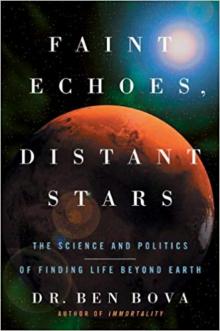Faint Echoes, Distant Stars_The Science and Politics of Finding Life Beyond Earth 

by Ben Bova
Genre: Science
Published: 2009
View: 6027
Read OnlineRead Faint Echoes, Distant Stars_The Science and Politics of Finding Life Beyond Earth Storyline:
Our neighboring planets may have the answer to this question. Scientists have already identified ice caps on Mars and what appear to be enormous oceans underneath the ice of Jupiter's moons. The atmosphere on Venus appeared harsh and insupportable of life, composed of a toxic atmosphere and oceans of acid -- until scientists concluded that Earth's atmosphere was eerily similar billions of years ago.An extraterrestrial colony, in some form, may already exist, just awaiting discovery.
But the greatest impediment to such an important scientific discovery may not be technological, but political. No scientific endeavor can be launched without a budget, and matters of money are within the arena of politicians. Dr. Ben Bova explores some of the key players and the arguments waged in a debate of both scientific and cultural priorities, showing the emotions, the controversy, and the egos involved in arguably the most important scientific pursuit ever begun.
**From Publishers Weekly
In 1910 the earth whirled through the tail of Halley's comet. Eight years later, in the final months of WWI, the "Spanish flu" pandemic struck, killing tens of millions worldwide. Could biological organisms in the comet's tail have made their way to Earth, causing this great outbreak of disease, like some early Andromeda strain? After all, many scientists hold to the panspermia thesis, that comets seeded the infant Earth with water-and life. But how could any organism survive the cold, radiation-drenched vacuum of space? Bova, a popular science fiction author and National Space Society president emeritus, demonstrates in this lively survey how resilient life really is. One little organism called D. radiodurans, a regular Conan the bacterium, can survive radiation that would fry any other known life form. Interstellar bodies often contain water in the form of amorphous ice, whose fluid structure is closer to that of glass than regular ice and can allow life to exist, or even come into being, inside it. Bova gives a comprehensive overview of the changing fortunes of astrobiology, so often the victim of political and economic expediencies, and lays out our species' best options for surviving our own actions as well as objects that may come zooming at us from out of the cosmos. The author sometimes lets his enthusiasm carry him into flights of hyperbole and even misstatements. Most scientists don't believe that life on earth needs to worry about the moon losing momentum and one day breaking apart above our heads. And early forms of life did colonize Antarctica, contrary to Bova's claim; the continent wasn't in a deep freeze millions of years ago. This book will excite science buffs while being accessible to general readers hoping to one day meet our extraterrestrial relations. 16 pages of b&w photos not seen by PW.
Copyright © Reed Business Information, a division of Reed Elsevier Inc. All rights reserved.
From Booklist
Bova proffers a good general history of astrobiology, or the history and structure of life in the cosmos--one of the newest fields of scientific research. He covers astronomy briefly and gives more detail about the political and technological history of NASA, showing the effects of politics and accidents on the field. He also notes what we have discovered about the history of life on this planet, what we are looking for beyond Earth and the solar system, and how we are presently going about it. With so much to cover, this is hardly an in-depth account, but it is a very good introduction for the general reader and even the specialist who wants a look at the larger picture. Bova seasons his account with entertaining and illustrative historical anecdotes, so that, as a bonus, we get an idea of what NASA has been doing since the end of the Apollo program and something about what it hopes to do in the future that many readers will live to see. Frieda Murray
Copyright © American Library Association. All rights reserved
Pages of Faint Echoes, Distant Stars_The Science and Politics of Finding Life Beyond Earth :